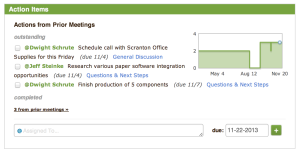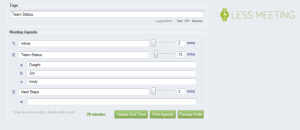Stand-up Meetings
A slap in the face to mundane, never-ending meetings that you dread going to on Monday morning.
Why?
- They keep the meeting focused & on topic
- They eliminate distractions like phones and computers
- They prevent people from getting on their soapboxes
- …and most importantly they are short, letting you get back to your real work
What You Might Not Realize About Stand-Up Meetings
People love to praise how the stand-up nature of the meeting keeps them short. And for good reason.
But did you know that one biggest benefits of stand-up meetings has nothing to do with standing up?
As Dan Markovitz of TimeBack Management points out, moving to a stand-up style meeting format causes you to meet more often (albeit in shorter amounts). So instead of meeting every Monday for 2 grueling hours, you meet for just 15 quick minutes Monday through Friday.
And here’s the big reveal – When you start meeting more frequently you identify issues sooner, so you can, in turn, take corrective action immediately.
“The daily standup meeting keeps the manager apprised of what’s going on each day, and helps spot problems before anyone invests time or money.”
Small Batches of Work Trumps Mass Production
Decades ago Toyota proved the method of building in small batches – build only a few items at a time from start to end – is much more efficient than mass production, or the assembly line method.
Although it feels counterintuitive to think this works, study after study has shown that small batches always win out over assembly lines.
Why?
In a word…REWORK.
When issues come up – which they will! – mass production becomes very inefficient. When Toyota adds doors to 1,000 cars at once, what happens when they find out on door #579 that the machinery has misaligned the previous 578 doors? Now you’re forced to waste time taking 578 doors off and adding 578 new doors a second time.
The same happens with project work. Waiting days or weeks to provide feedback on a presentation your team member is creating? Then don’t be surprised when he’s forced to scrap 50% of the slides and start over because he was addressing the wrong problem.
Approaching your projects and meetings in small batches allows leadership to spot errors and correct them early on.
Small Batch Stand-Up Meetings with Less Meeting
Let’s stop with the theory and get down to action.
Here are three easy ways you can use Less Meeting to help you meet in short, small batches so you spot errors early.
1. Copy Team Members on Meeting Minute Emails
When Less Meeting sends out your meeting minutes, add people who weren’t in the meeting but still need to know outcomes. This allows team leaders to spot problems from afar without having to be in every meeting.
2. Track Action Items Across Recurring Meetings
Context is key, which is why Less Meeting links all the related information across a recurring meeting series. So if you have a daily standup you can easily see the action items that were assigned recently. This ensures frequent checkpoints on those tasks so you don’t go weeks without checking up on their status.
3. Plan Timing for Each Agenda Item
Stop scheduling meetings in 30 or 60-minute blocks just because that’s what Outlook’s default is. Use the Less Meeting Outlook Add-in to let you time your meeting based on each agenda item. If you’re going to be meeting more often, you need to have shorter meetings.
Did you know Less Meeting users schedule on average 17% shorter meetings this way?
Are you trying to avoid unnecessary rework and project waste? Signup for a free Less Meeting trial today and find out how you can start having small batch stand-up meetings with Less Meeting.








